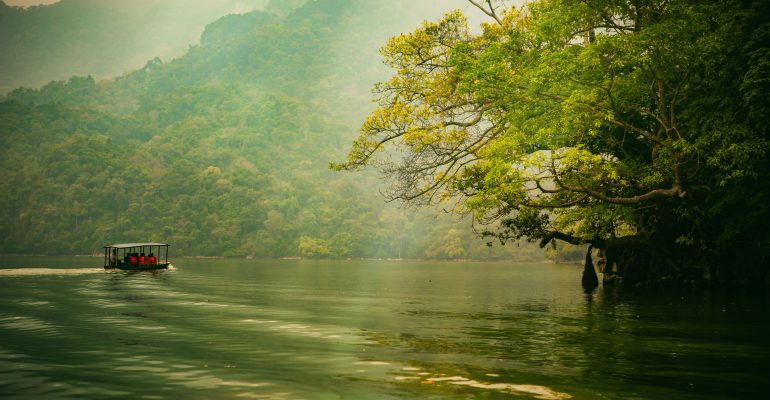Walk, boat or trek to explore Vietnam’s largest fresh water lake and its natural and cultural environs.
It’s a wholesome threesome.
As the name Ba Be suggests, the lake is actually made of 3 smaller lakes – Pe Lam, Pe Lu and Pe Leng; and it is fed by three rivers – Ta Han, Bo Lu, and Leng. And, to stretch things a bit, it can be enjoyed in three ways.
Ba Be Lake is the heart of the Ba Be National Park in Ba Be District, Bac Kan Province (Northeast Vietnam).
Mountains, valleys, rivers, waterfalls, caves and villages steeped in traditional, unique ethnic minority cultures – a visit to this lake and the complex it is located in is an exploration of natural beauty in its myriad forms.
In 2011, UNESCO recognized Ba Be Lake as a Ramsar site or a wetland of international importance.
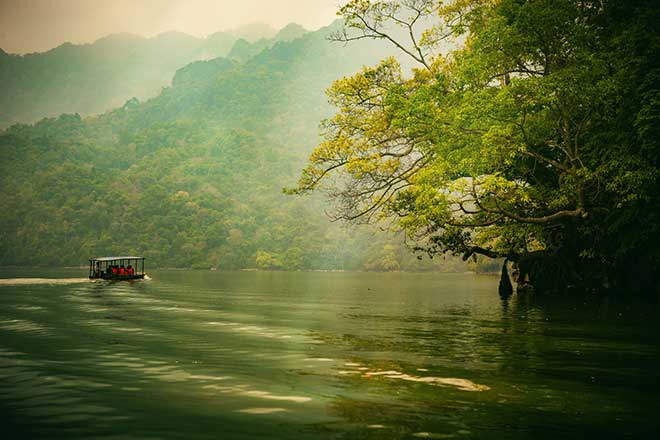
Photo by Shutterstock/hoangnam
Ba Be Lake nestles in vast limestone mountain range with millions of crags and crevasses that create an ideal environment for large variety of marine life. There are over a hundred species of freshwater fish living in the lakes.
As the lake, or lakes, are shielded by a mountain range and dense forests, the area remains fresh and cool throughout the year, making it a perfect escape from the scorching heat of summer elsewhere in the country.
Three ways to explore Ba Be Lake
Depending on your mood and/or convenience, the lake and its environs can be explored with a boat ride, a casual walk or a long trek through the countryside.
A boat ride starting early in the morning opens up the possibility of experiencing the mystical beauty of the lake, with the early rays of the sun piercing through the fog that still lingers over a calm, still lake.
A five-hour cruise to all the popular spots on the lake in a boat that can carry up to 10 people costs VND800,000 – 1 million ($34 – 43).
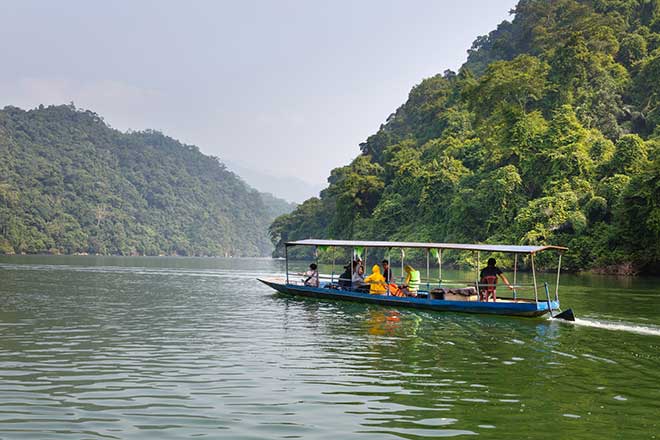
Photo by Shutterstock/anhanh
Great stops on the boat ride through picturesque scenery include the Dau Dang Waterfall, Tien Pond (Fairy Pond), An Ma Shrine and Ba Goa Island (Widow Island).
Dau Dang Waterfall: Lying between two limestone mountains on Nang River, Dau Dang is a small but beautiful 3-level cascade. Each “step” is only about 3-4 m from each other. This is also the habitat a special type of fish that can weigh several dozen kilos.
Tien Pond (Fairy Pond): Tien Pond is about 3 hectares wide, surrounded by tropical forests and limestone mountains. Its clear turquoise waters capture and reflect the areas splendor like a mirror. The legend is that the place is a favourite bathing spot of angels in heaven.
An Ma Shrine: The shrine is built on An Ma island in the middle of Ba Be Lake. It is a very sacred place for locals. Two festivals are organized every year at the shrine: the Ba Be Spring Festival on the 10th day of the first lunar month; and the An Ma Shrine Festival, on the 6th day of the second lunar month.
Ba Goa Island (Widow’s Island): This tiny island in the middle of Pe Leng Lake is usually the last stop on the cruise. Widow’s Island is made up of rocks of different shapes and sizes piled up on each other. Perenially green trees grow out these rocks. The legend is that the island was once home to a widow and her children who helped save the people of the village during a great flood that created Ba Be Lake.
The boats moving through the calm waters as the sun sets in the sky is a peaceful, calming way to end the day.


 Walk and talk
Walk and talk
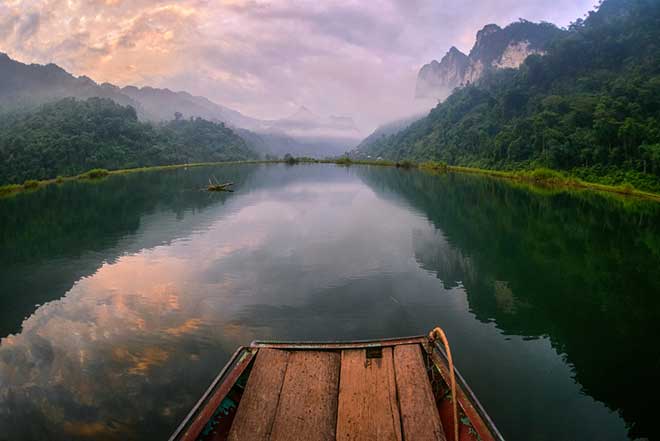
Photo by VnExpress/Cao Anh Tuan
Another great way to discover the charms of the Ba Ba Lake area is to interact with the Tay ethnic minority community, who usually live by the water and in areas around the lake. Walking and cycling through their villages and engaging locals in conversation about their daily lives is the best way to explore and discover local culture.
A few notable mentions are the villages of Coc Toc, Bo Lu and Pac Ngoi. The beautiful paddy fields, vegetable gardens (potato, in particular) and stilt houses in the water show visitors a way of life that’s almost a dream.
At Pac Ngoi, a Tay village located on the banks of Leng River, visitors can try and get closer to local life, sleeping in stilt houses, partaking of local specialties, exploring the lake in dugout canoe and watching Tay women dancing, singing and playing music. The village has several caves and waterfalls that visitors can check out too.
Hua Ma Cave: This cave is located on Co Don Mountain amidst a dense forest. Visitors will need to climb up 300m of stairs to reach the cave’s entrance. The inside of the cave is 700m long and 40-50m high in some parts. There are a few spooky stories associated with the cave, and locals will narrate them to you, if you are interested. There’s a VND22,000 ($9) entrance fee to the cave.
Tat Ma Waterfalls: Also called Silver Falls, this is about 40m high. It cascades straight down a steep cliff surrounded with greenery into a small but clear pond with large rocks underneath. Visitors can take a refreshing dip in the cool waters here. The view at the bottom of the waterfall is spectacular. It’s like a colourful painting – the white of the foaming water, the green of trees and the purple and reddish tinges of the rocks. Add to this the fragrance of flowers and the earthy scent.
On Saturday mornings, visitors have the option of visiting the colorful Nam Cuong Market where where Tay and Mong people sell many of their products, including fabric, clothes hairpins and food. Apart from locals, ethnic Tay people from other places also sell their stuff, including a special kind of incense.
A trek through wonderland
Those who favour trekking have the opportunity to experience life that has remained unchanged for years and years.
The trek starts in the morning at Bo Lu Village and moves up to Coc Toc Village, and then follows a path straight up the mountain. The trek will take around half a day. Along the way, visitors will pass several Mong villages like Na Phai, Dan May and Nam Dai where people live in enviable proximity to nature on the high mountain.
The people here still wear their traditional Mong dresses, grow corn and cassava on terrace fields. March and April is a beautiful time to visit this place, with the path lined by trees on which thousands of beautiful tiny white flowers are in bloom.
The last stop, after the trek is done, is Na Hang Lake, which can be explored on local boats.
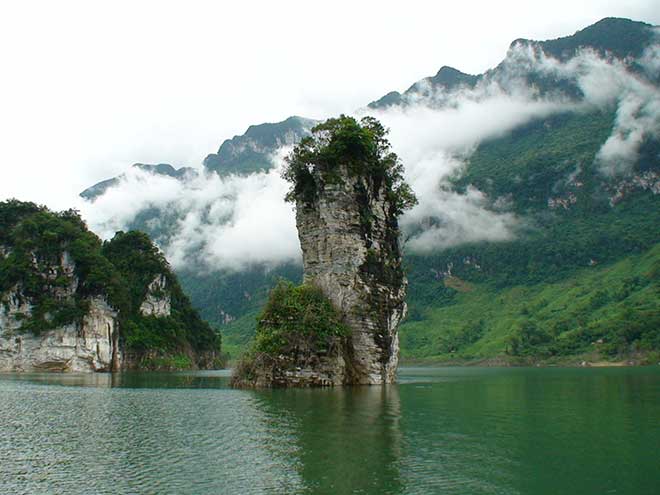
Things to remember
– The Ba Be Spring Festival is celebrated on the 9th and 10th day of the first lunar month. It features several folk games and activities, including rowing, archery and wrestling contests, nem con (throwing a cotton ball through a ring) and performances of traditional dances and songs.
– Care should taken when trekking through the forest and mountain. The path can be quite slippery, especially after it rains.
– If visitors book homestay accommodation at the lake, they will be offered a boat cruise at a discounted price.
– The trek is of moderate difficulty and there are no stores on the way, so make sure to prepare enough food and water for the whole day.
From Saigon, take a flight to Hanoi.
Ba Be is around 240km north of the capital city, a drive of about five hours. Visitors can also take a bus. There are a few companies that offer rides straight to Ba Be from Hanoi. The way to Ba Be from Hanoi is also very beautiful.
Please keep in mind that the road can be dangerous, especially during rainy days, so make sure to drive carefully. Although a motorbike is more convienent if one wants to feel the fresh wind on the skin or stop along the way for photos, visitors should only do this if they are experienced drivers and are comfortable driving for long distances.
Accommodation: Homestays and hotels are both good options, depending on your interest and needs. There are many good hotels and homestays to choose from when you visit Ba Be.
Story by Huynh Kien, Linh Nguyen
Photos by Cao Anh Tuan
VnExpress.net

